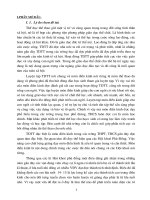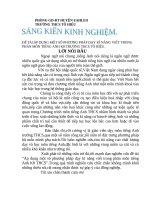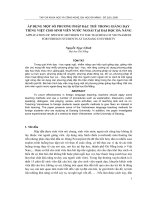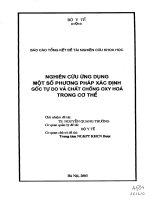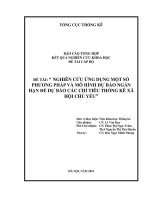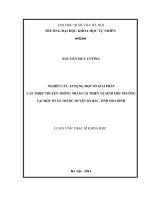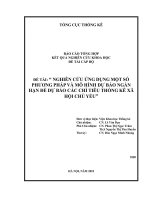Nghiên cứu áp dụng một số phương pháp sàng lọc sarcopenia ở người bệnh cao tuổi
Bạn đang xem bản rút gọn của tài liệu. Xem và tải ngay bản đầy đủ của tài liệu tại đây (354.99 KB, 25 trang )
1
INTRODUCTION
Sarcopenia is defined as a progressive and generalized loss
of muscle mass and physical function. Sarcopenia is now recognized
as an independent disease and has its own International Sarcopenia is
independently associated with health adverse outcomes, such as falls
and fractures, dependences, hospitalization, and mortality.
Three extensive and valuable screening tools, including
SARC-F questionnaire, SARC-F adding calf circumference (SARCCalF) and Ishii’s formula, were recommended by international
sarcopenia working groups that could be used to initially screen for
sarcopenia. However, in the literature, no study on comparison of
their reliability and validity has yet been performed in the same study
population. And there has been no study on the application of these
screening tools in older patients in Vietnam. Therefore, we conducted
the study “Validation of sarcopenia screening tools among older
paptients” with three aims:
1. Assess the prevalence of sarcopenia and associated factors in
patients attending geriatric clinics in Vietnam
2. Evaluate the diagnostic accuracy of the SARC-F, SARC-CalF
and Ishii’s formula in the screening for sarcopenia among older
patients.
3. Investigate the relation between value of three screening tools
with health adverse outcomes among older patients after 18
months follow-up.
Necessity of the thesis
Most of diagnostic tools are not widely available, especially in lowmiddle income countries such as Vietnam. It has been proposed that a
valuable, simple and inexpensive tool could be used to initially
screen for sarcopenia. Some screening methods were developed by
research teams with the aim to rapidly identify individuals who
require a diagnostic examination for sarcopenia. Indeed, the early
identification of older adults likely to suffer from sarcopenia would
allow them to implement, at an early stage, preventive strategies
including protein supplementation and physical activity in
combination. Three extensive and valuable screening tools, including
SARC-F questionnaire, SARC-F adding calf circumference (SARC-
2
CalF) and Ishii’s formula, were recommended by AWGS 2019 and
EWGSOP2 that could be used to initially screen for sarcopenia. They
have been shown to be valid in a number of studies.
New contributions of the thesis
Prevalence of sarcopenia among older patients 61.2%, higher in male
and advance age. Related factors for sarcopenia: age, male,
underweight, low physical activity, being malnourished and chronic
lung disease.
Screening tools including SARC-F, SARC-CalF and Ishii’formular
has acceptable sarcopenia diagnostic value for older patients, in
comparision with gold standard AWGS 2019 criteria. Of three
screening tools, Ishii’s formula showed the best sensitivity, negative
predictive value, accuracy and the largest area under the receiver
operating curve to identify sarcopenia in older outpatients.
High value of Ishii’s formular at baseline was related with increasing
short-term health-related outcomes among older patients (all causes
mortality, incidence of fall or dependence of activities daily living).
Thesis outline
The thesis consits of 126 pages, including: introduction (2 pages),
overview (34 pages), object and methods (28 pages), results (30
pages), discussion (29 pages), conclusion (2 pages) and
recommendation (1 page). 158 English and Vietnames references.
Chapter 1
LITERATURE RIVIEW
1.1.
Definition of sarcopenia
Sarcopenia is a syndrome characterised by
progressive and generalized loss of skeletal muscle mass and
strength with a risk of adverse outcomes such as physical
disability, poor quality of life and death.
1.2. Prevalence of sarcopenia
Prevalence of sarcopenia in the world was evaluated in a systematic
review and meta- analysis of general population studies. The studies
that reported the prevalence of sarcopenia in people aged ≥ 60 years
in community setting based on the EWGSOP, the International
Working Group on Sarcopenia (IWGS) and AWGS criteria, were
selected. With a total of 58404 individuals, the overall estimates of
sarcopenia prevalence was 10% (95%CI: 8-12%) in male and 10%
3
(95%CI: 8-13%) in female, respectively. The prevalence was higher
among non- Asian than Asian individuals in both genders (11% vs
10% in male, 13% vs 9% in female).
The global prevalence of sarcopenia was around 6-22 % in people
aged 65 years or older, increased with age and varied across regions.
In Western countries, the prevalence of sarcopenia was around 20%
among people aged ≥65 years, and 50%-60% in people aged ≥80. In
Asian countries, the review of epidemiology studies that used AWGS
2014 criteria discovered that the prevalence of sarcopenia ranged
from 5.5% to 25.7%, with male predominance (5.1%-21.0% in male
vs 4.1%-16.3% in female).
1.3.
The recommendation of screening for sarcopenia
The guidelines of screening for sarcopenia were developed upon
the best available evidence from systematic reviews paired with
consensus statements by international working groups on sarcopenia.
(1) Older adults aged 65 years and older should be screened for
sarcopenia annually, or after the occurrence of major health
events
There is currently no direct evidence in support of a specific
frequency for sarcopenia screening, and it is likely that new research
evidence would impact on the certainty of this recommendation.
Regular screening for sarcopenia should be applied for older people
with several reasons:
- All older adults are at risk of developing sarcopenia,
particularly those with low physical activity levels.
- Sarcopenia is common across all older populations and may
be transient in its early stages.
- Sarcopenia places a heavy burden on the individual, their
care-giver, and the healthcare system.
- Screening for sarcopenia is effective.
(2)
Screening tools for sarcopenia
Screening tests for sarcopenia need to be rapid and easy to use.
- According to AWGS 2019 Consensus Update on Sarcopenia
Diagnosis and Treatment, calf circumference, SARC-F or SARCCalf questionnaire were the choosing tools for sarcopenia case
finding in:
+ Primary health care or community preventive services settings
4
+ and Acute to chronic health care or clinical research settings.
- In revised European consensus on definition and diagnosis of
sarcopenia
+ SARC-F questionnaire was proposed as choosing tools for
sarcopenia case finding in clinical practice and in research;
+ Ishii screening tool was recommended to use in clinical practice.
- Gait speed is well recognised as a screening tool for
sarcopenia according to EWGSOP recommendation in 2010.
(3) Individuals screened as positive for sarcopenia should be
referred for further assessment to confirm the presence of the
disease.
All international consensus statements agree with the importance
of an assessment referral after a positive screening. There are two
main reasons for this recommendation:
- Unmanaged sarcopenia can quickly increase risk for mortality and
functional decline.
- Detection of sarcopenia in its early stages may significantly
contribute to less morbidity and mortality related to the condition.
Chapter 2
MATERIALS AND METHOD
2.1. Study population
Consecutive patients aged 60 years or above visiting the
Outpatient Department of the National Geriatric Hospital in Hanoi,
Vietnam were recruited.
2.1.1. Inclusion criteria
Study participants had all the criteria: Aged 60 years or above; Have
ability to perform all physical examinations.
2.1.2. Exclusion criteria
Study participants having one of following criteria were excluded:
- Blind or deaf;
- Pace-maker implanted or had metal medical devices;
- Severe illness (receiving intensive care)
- Unable to provide consent or refused to participate in the study.
2.2. Study design
Observational study was conducted:
5
+ Objectives 1 and 2: Cross-sectional study
+ Objective 3: Longitudinal study
2.3. Sample size
Consecutive patients aged 60 years or above visiting 05
outpatient clinics, National Geriatric Hospital were recruited.
2.3.1. Sample size for estimation prevalence of sarcopenia in
older patients (Cross-sectional study 1)
The sample size was determined using a single population proportion
formula:
As there has been no study on sarcopenia in geriatric patients in
Vietnam, we assumed p to be 50%. Therefore, the sample size for our
study was calculated to be at least 384 participants.
2.3.2. Sample size for test on validity of sarcopenia screening
tools (cross-sectional study 2)
N for sensitivity 95% was 132, and N for specificity 80% was 550.
We interested in both sensitivity and specificity, then we take the
higher number (N=550).
Our expected rate of missing data was 10% The sample size of crosssectional study for test on validity of sarcopenia screening tools was
at least 605.
2.3.3. Sample size for assessment the sarcopenia-related adverse
outcomes (Longitudinal study 3)
Formular calculation for hypothesis test for two population
proportion (two side test):
N = 166. Our expected dropout rate was 20%. Thus, the sample size
for the longitudinal study was at least 200.
2.4. Study setting
- Location: Outpatient Department, National Geriatrics Hospital
- Time: From January 2018 to April 2020
2.5. Data collection
Data was collected from medical records, patient interviews and
physical examination. Trained interviewers collected the data from
participants
via
face-to-face
interviews.
Anthropometric
measurements and other physical assessments were performed by
five well-trained clinical research assistants. Follow up data was
obtained by telephone interview and clinical visits.
6
2.5.1.
Diagnosis of sarcopenia based on “gold standard”, Asian
Working Group on Sarcopenia (AWGS) criteria
In our studies, sarcopenia was defined as low muscle mass
plus low muscle strength using cut-points suggested by the Asian
Working Group on Sarcopenia (AWGS) [19].
2.5.1.1. Muscle mass
Muscle mass assessed by Appendicular skeletal muscle
adjusted by height square (ASM/height2).
+ Each participant received a whole body dual X-ray
absorptiometry scan (DXA Medic DR C12, Mauguio, France) to
measure regional lean mass (kg), total body fat (kg), and total body
fat percentage (%). It took 15 – 20 minutes for each person to do this
examination.
Appendicular skeletal muscle (ASM, kg) was defined as the sum of
the lean soft tissue masses of the arms and legs [71].
+ Height: Participants were measured against a convenient
flat wall. Participants were barefoot with arms hanging freely at the
side and eyes looking straight ahead.
2.5.1.2. Muscle strength
Muscle strength was evaluated by hand grip strength test.
+ Handgrip strength (HGS, kg) was measured using a
dynamometer (Jamar TM Hidraulic Hand Dynamometer 5030 J1
made in USA) .
+ Participants were asked to sit on a chair, bend the elbow at
a 90 – degree angle and do not touch the body. The participants
gripped the dynamometer as much as possible with each hand, twice
a hand. The highest value was used. Handgrip dynamometer was
calibrated regularly to ensure reliable and accurate results of muscle
strength.
According to “gold standard” AWGS, sarcopenia was
defined as having (1) low muscle mass, plus (2) low muscle
strength [19]:
(1) Low muscle mass was defined by ASM/height 2: < 7.0 kg/m2
in male; < 5.4 kg/m2 in female
(2) Low muscle strength: Low HGS cut-points were: < 28 kg in
male; < 18 kg in female
7
2.5.2.
Sarcopenia screening tools: SARC-F, SARC-CalF and
Ishii’s formula
2.5.2.1.
Translation and adaption of the SARC-F questionnaire
Participants self-completed the SARC-F questionnaires. The
SARC-F composed of 5 components including strength, assitance in
walking, rise from the chair, climb stairs and falls.
The Vietnamese version of the SARC-F was adapted following
standardized forward–backward translation procedure. Two
independent geriatricians translated the English version into
Vietnamese language. In Vietnam, people use the unit of "kg" instead
of "pound", therefore question 1 “How much difficulty do you have
in lifting and carrying 10 pounds?” was modified to “How much
difficulty do you have in lifting and carrying 4.5 kg?”. An English
native speaker who had no knowledge of the wording from the
original English version conducted backward translation. The two
translations were compared item by item and revised upon agreement
among the authors and the three translators. The English and
Vietnamese versions of the SARC-F are shown
The total score of the SARC-F questionnaire ranges from 0
to 10 points, and a score ≥ 4 indicates sarcopenia.
2.5.2.2. SARC-CalF tools
The SARC-CalF was developed adding calf circumference
(CC) to the SARC-F questionnaire:
(1) Each components of SARC-F questionnaire are scored as
above (0 – 2 scores each question).
(2) Calf circumference (CC):
CC measurement was made at the maximum circumference
of the lower non-dominant leg with the participant’s leg bent 90°
degrees at the knee. The measurement was conducted in both legs
and the higher value of the two measurements was used for the
analysis. Scoring of CC was as bellows:
Male: > 34 cm = 0 point ≤ 34 cm = 10 points
Female:
> 33 cm = 0 point ≤ 33 cm = 10 points
The total score was calculated as sum of score of five
questions and of CC score. A SARC-CalF score ≥ 11
indicates sarcopenia [22].
2.5.2.3. Ishii’ formula
8
Ishii’s formula was based on age, calf circumference (CC)
and handgrip strength (HGS) [21]. Sarcopenia score was calculated.
HGS and CC were evaluated as above.
The formula to calculate the total scores were as follows:
In male: 0.62 × (age − 64) − 3.09 × (HGS − 50) − 4.64× (CC − 42);
In female: 0.80 × (age − 64) − 5.09 × (HGS − 34) − 3.28× (CC − 42)
The cut-points of total Ishii scores for defining sarcopenia
were: ≥ 105 for male; ≥120 for female
2.5.2.4. Short-term health-related outcomes: at 9 and 18 months
follow-up
Follow-up data were collected by telephone and clinical visits
combined with the medical record. The data were collected by welltrained clinical research assistants.
Loss to follow-up was considered when participants did not
have a new admit to the outpatient clinics, National Geriatrics
Hospital or if the participants could not be reached by at least 05
telephone calls at different times during the follow-up period. The
follow-up time was calculated from the enrolment and all participants
were followed up for 18 months. A total of 05 patients (2%) was loss
follow-up at 18 months follow-up.
All-causes mortality
At 09 and 18 months during the follow-up period, the
survival status of the participants obtained via telephone interviews.
All the mortality events were confirmed and the period (month) from
the first investigation to the date of mortality was recorded.
Incidence of fall
Incidence of fall was obtained for participants who did not
have the history of falls in the last 12 months in the baseline
investigation. At 09 and 18 months follow-up after the baseline
investigation, we asked each participant the following questions:
“Have you fallen in the past nine months?” Fall was defined as
“unintentionally coming to rest on the ground, floor or other lowerlevel”.
Incidence of dependences
Incidence of ADL and IADL dependences was obtained for
participants who did not have dependences in the baseline.
Incidence of daily activities activity was defined as
9
progression from those without limitation at baseline to having
limitation at follow-up. The rates of incidence of dependences were
noted.
2.6. Statistical analysis
Data were managed in Redcap. Analysis of the data was
performed using SPSS for Windows 20.0 (IBM Corp., Armonk, NY,
USA).
Continuous variables are presented as mean (± standard
deviation), and categorical variables as frequency and percentage.
Comparisons between participants with and without sarcopenia or
between male and female were assessed using Chi-square tests for
categorical variables and Student’s t-tests for continuous variables.
Two-tailed P values < 0.05 were considered statistically significant.
The internal consistency of the SARC-F was assessed by
Cronbach’s alpha and item to total correlation coefficients. The value
of Cronbach’s alpha ≥0.70 indicating an acceptable level of internal
consistency. The item-total correlation coefficients are Pearson’s
correlation which ranges from 0 to 1, with the higher value indicating
the better consistency.
To assess the validity of, such as SARC-F, SARC-CalF and
Ishii’s formula, the AWGS criteria was used as the gold standard for
diagnosing of sarcopenia. And thus the receiver operator curve
(ROC) was applied to evaluate the evaluate sensitivity (Se),
specificity (Sp), and area under the curve (AUC) of three screening
tools for cut-off points that proposed in preliminary studies The
accuracy measures the proportion of correct classifications over the
total number of classifications. The positive predictive value (PPV) is
the probability of having sarcopenia defined by the AWGS in
participants with sarcopenia defined by screening tools (true
positive). The negative predictive value (NPV) is the probability of
not having sarcopenia (defined by the AWGS) in participants without
sarcopenia defined by screening tools (true negative). The higher
values of accuracy, PPV and NPV indicate the higher diagnostic
validity of SARC-F.
Multivariate logistic regression was also used to determine the
effect of sarcopenia on health adverse outcomes, including:
(1) All-causes mortality (Adjusted by living alone, having
10
history of hospitalization in the last 12 months, dependences in
instruments activities daily living, frailty, depression, low Time up
and go test, diabetes and hypertension).
(2) Incidence of fall (Adjusted by age, gender, history of
hospitalization in the last 12 months, malnutrition, low physical
activity level, dependence in activities daily living, frailty,
depression, cognitive impairment, diabetes and hypertension).
2.7. Ethical consideration
The study was approved by the National Geriatric Hospital
Ethics Committee, Hanoi, Vietnam (No.1235/QD-BVLKTW
November 15 2017). Written informed consent was obtained from
participants before starting the study.
Chapter 3
RESULTS
3.1.
3.1.1.
Prevalence of sarcopenia and related factors
among older patients
Prevalence of sarcopenia
During the study period, 916 were approached, of whom 802
(87.6%) agreed to take part in the study. Due to missing data on
physical examination or DXA measurement, 38 participants (4.7%)
were excluded. Thus, the final study population comprised 764
participants
80
72.2
70 61.2
60
52.8
50
40
30
20
10
0
AGWS 2019
75.3
49.2
52.8
59.4 56.3 61.2
43.5
SARC-F
SARC-CalF
65.5
59.5
Tổng
Nam
Nữ
Công thức Ishii
11
Figure 3.1. The proportion of sarcopenia according to gender based
on different criteria
The proportion of sarcopenia was 61.2% (72.2% in male and
52.8% in female) based on AWGS criteria (Figure 3.3). Using SARCF and SARC-CalF questionnaire, 49.2% and 59.4% were defined as
having sarcopenia, respectively. According to Ishii’s formula, the
proportion of sarcopenia was 65.5%.
100
80
60
40
20
0
89.5
45.4
65
54 .6
35
10.5
60 - 69 years
70 - 79 years
Sarcopenia
≥ 80 years
Non sarcopenIa
Figure 3.2. Prevalence of sarcopenia according to age groups
Prevalence of sarcopenia was statistically increasing with
age, ptrend <0.001 (Figure 3.1.). Sarcopenia was accounted for 42.7%
in 60 – 69 years old group. The proportion of sarcopenia was 59.3%
in 70 – 79 years old group. And 90.2% of patients aged ≥ 80 years
were sarcopenia.
92.1
89.8
78.5
59.1
54
40.9
58.3
46
41.7
21.5
10.2
Yes
7.9
no
Yes
no
Yes
no
12
Figure 3.3. Prevalence of sarcopenia according to nutritional status,
physical activity level and frailty status
The vast majority of study participants with malnutrition
status (91.7%) or frailty (92.5%) were diagnosed with sarcopenia.
The proportion of people with sarcopenia was more common
among low physical activity level group (76.1%) than among
moderate-to-high physical activity level group (51.8%).
3.1.2.. Related factors with sarcopenia among older patients
Table 3.1. Potential factors associated with sarcopenia on
multivariate logistic regression
Adjusted odds ratios
Variables
for sarcopenia
P
(95%CI)
Age
1,08 (1,01 – 1,12)
<0,001
Male
2,05 (1,19 – 4,51)
0,002
Under weight (BMI 2,32 (1,22 – 4,41)
0,010
<18.5 kg/m2)
Chronic lung diseases 3,68 (3,10 – 5,79)
<0,001
(COPD/Asthma)
Malnourished (MNA < 3,90 (1,21 – 10,91)
0,024
8)
Low physical activity 7,31 (3,74 – 11,01)
<0,001
level
COPD, chronic obstructive pulmonary disease.
In multivariate logistic regression, age, underweight, being
malnourished, chronic lung diseases were significantly associated
with sarcopenia defined by AWGS criteria (Table 3.6.).
3.2.1.1. Reliability of SARC-F questionnaire
Over all, the SARC-F score was 3.2 ± 2.4 on average.
Table 3.2. Internal reliability of the SARC-F Vietnamese version
Domains
Strength
Score [n (%)]
0
1
2
242
(31.7)
343
(44.9)
179
(23.4)
Mean
(SD)
0.9 (0.7)
Item-total
correlation
0.84
13
Assistance
in walking
357
(46.7)
380
(49.7)
27
(3.5)
0.6 (0.6)
0.86
Rise from
a chair
320
(41.9)
419
(54.8)
25
(3.3)
0.6 (0.6)
0.86
Climb
stairs
244
(31.9)
413
(54.1)
107
(14.0)
0.8 (0.7)
0.85
Fall history
576
(75.4)
168
(22.0)
20
(2.6)
0.3 (0.5)
0.50
Total score
3.2 (2.4
)
Table 3.2. displays the internal consistency of the SARC-F
questionnaire, with the Cronbach’s alpha value 0.85.
All of the five items were correlated to the total score of the
questionnaire. Item-total correlation was in range from 0.50 to 0.86.
3.2.1.2.
Validity: Comparison of three sarcopenia screening tools
against gold standard
The diagnostic values of SARC-F were assessed by
comparing to “gold standard” AWGS criteria.
Table 3.3. Diagnostic values of three screening tools against AWGS
crteria
AWGS
Sensitivit Specificit
PP
NP
Accurac
definition
y
y
V
V
y
(%)
(%)
(%) (%)
(%)
All population
SARC-F
questionnair
62.3
71.4
77.4 54.5
65.8
e
SARC-CalF
questionnair
72.6
61.0
74.7 58.4
68.1
e
Ishii’s
96.7
54.5
75.8 91.8
79.6
formula
In male
14
SARC-F
questionnair
e
SARC-CalF
questionnair
e
Ishii’s
formula
54.8
85.2
90.6
42.1
63.2
67.6
71.6
86.1
46.0
68.7
98.4
54.2
84.9
93.0
86.1
In female
SARC-F
questionnair
68.5
66.0
70.7 63.7
67.4
e
SARC-CalF
questionnair
76.7
57.0
68.2 67.0
67.7
e
Ishii’s
95.1
54.6
68.7 91.4
75.3
formula
Ishii’s formula had the better diagnostic value than SARC-F
and SARC-CalF tools.
Of three screening tools, the sensitivity and the negative
predictive value of Ishii’s formula were higher than those of SARC-F
and SARC-CalF screening tools, both in male and female (Table
3.9.).
The accuracy measures the proportion of correct
classifications over the total number of classifications. The accuracies
of three tools were 65.8% using SARC-F questionnaire, 68.1% using
SARC-CalF questionnaire and 79.6% using Ishii’s formula.
15
SARC-F: AUC 0.71 (95%CI: 0.67 – 0.74)
SARC-CalF: AUC 0.76 (95%CI: 0.72 – 0.80)
Ishii’s formula: AUC 0.88 (95%CI: 0.86 – 0.91)
Figure 3.4. Receiver operator curve (ROC) of three screening tools
against AWGS definition: all study population
Of three screening tools, Ishii’s formula showed the largest
area under the curve, AUC: 0.88 (95%CI: 0.86 – 0.91), p<0.001.
The AUC of SARC-F and SARC-CalF were higher than 0.7
(AUC 0.71 (95%CI: 0.67 – 0.74) and 0.76 (95%CI: 0.72 – 0.80)),
respectively. Validity of three sarcopenia screening tools for
predicting short-term health-related outcomes among older patients:
A longitudinal study
The sample size for the longitudinal study was at least 100
(for each group: sarcopenia and non-sarcopenia). The systematic
random sampling was applied, with k = 3, N = 764 (the sample size
of cross-sectional study 2). The estimated sample size for this
longitudinal study was 255, and 5 patients were lost the follow-up
the final sample was 250 older people.
3.2.2. Relation between value of three screening tools with health
adverse outcomes among older patients after 18 months
follow-up
16
16
14
12
10
8
6
4
2
0
14.3
13.3
5.1
12.6
Sarcopenia
Non-sarcopenia
5
0
SARC-F*
SARC-CalF* Ishii's formula**
* p<0.05; ** p<001
Figure 3.5. The rate of all-causes mortality among older patients
according sarcopenia status at 18 months follow-up (N=250)
Overall, the rate of all-causes mortality was 10% (25
patients). Using SARC-F or SARC-CalF screening tools, the rate of
of all-causes mortality at 18 months follow-up was significantly
higher in participants with sarcopenia than in those without
sarcopenia (14.3% and 13.3% compare to 5.1% and 5.0%,
respectively), p<0.05.
All the patients died at 18 months follow-up were diagnosed
as sarcopenia by Ishii’s formula in the baseline.
Table 3.4. Relationship between sarcopenia and all-causes mortality
at 18 months follow-up
Univariate
Mutivariate analysis:
analysis:
Adjusted OR (95%CI)
Sarcopenia
Unadjusted OR
Model 1
Model 2
(95%CI)
SARC-F
6.53
4.51
20.93
(1.90 – 22.45)
(1.22 –
(1.17 –
16.73)
375.75)
SARC-CalF
2.95
1.61
(1.07 – 8.15)
(0.51 – 5.07)
17
Ishii’s
formula
-
-
-
Model 1: Adjusted by age and gender
Model 2: Adjusted by age, gender, history of hospitalization in the
last 12 months, malnutrition, low physical activity level, dependence
in activities daily living, frailty, depression, cognitive impairment,
diabetes and hypertension.
In multiviariate logistic regression, sarcopenia was related
with increased risk of all-causes mortality at 18 months follow-up
(using SARC-F questionnaire: OR 20.93, 95%CI 1.17 – 375.75),
adjusted by age, gender, malnutrition, low physical activity level,
history of hospitalization in the last 12 months, dependence in
activities daily living, frailty, depression, cognitive impairment,
diabetes and hypertension (Table 3.20.).
40
30
35.9
33
26.9
36.4
27.7
22.2
20
10
0
SARC-F
SARC-CalF
Sarcopenia
Ishii's formula*
Nonsarcopenia
*p<0.05
Figure 3.6. The rate of incidence of falls among older patients
without history of falls at 18 months follow-up (N=196)
Among older people without history of fall, 61 older people
fell during the 18 months follow-up of the study.
The rates of incidence of fall among sarcopenic patients
defined by Ishii’s formula (36.4%) were significantly higher than
non-sarcopenic patients (22.8%).
Table 3.5. Relationship between sarcopenia and incidence of fall
at 18 months follow-up
Sarcopenia
Univariate
Mutivariate analysis:
18
SARC-F
SARC-CalF
Ishii’s
formula
analysis:
Unadjusted OR
(95%CI)
0.12
(0.90 – 2.44)
0.42
(0.74 – 2.05)
2.00
(1.09 – 3.68)
Adjusted OR (95%CI)
Model 1
Model 2
0.35
(0.73 – 2.46)
0.82
(0.57 – 2.04)
2.23
(1.06 – 4.70)
0.83
(0.59 – 1.95)
0.71
(0.60 – 2.09)
2.48
(1.12 – 5.50)
In univariate logistic regression, sarcopenia was an
independent predictor factor for the incidence of fall at 18 months
follow-up (95%CI 2.00, 95%CI: 1.09 – 3.68, based on Ishii’s
formula).
In multiviariate logistic regression, sarcopenia was related
with increased risk of incidence of fall at 18 months follow-up (using
Ishii’s formula: OR 2.48, 95%CI: 1.12 – 5.50), adjusted by living
alone, having history of hospitalization in the last 12 months,
dependences in instruments activities daily living, frailty, depression,
low Time up and go test, diabetes and hypertension.
SARC-F
SARC-CalF
4.4
16.4 23
Ishii's formula
53.6
41.9 49
*n1 = 124; **n2 = 115. ADL: Activities Daily Living; IADL:
Instruments Activities Daily Living.
19
Figure 3.7. Proportion of incidence of dependences in activities daily
living in sarcopenic patients diagnosed by different criteria
The incidences of dependences in activities daily living were
assessed among independent participants defined by ADL scale (n 1
=124) and by IADL scale (n2 = 115) at baseline.
Of sarcopenic participants defined by SARC-F, SARC-CalF
and Ishii’s formula, the incidence rates of ADL dependence were
4.4%, 16.4% and 23.0%, respectively.
About a half of sarcopenic patients had the incidence of
IADL dependence at 18 months follow-up.
Table 3.6 Relationship between sarcopenia and dependence of
activities daily living at 18 months follow-up
Univariate
Mutivariate analysis:
analysis:
Adjusted OR (95%CI)
Sarcopenia
Unadjusted OR
Model 1
Model 2
(95%CI)
SARC-F
0.67
0.68
0.66
(0.36 – 1.27)
(0.34 – 1.36) (0.32 – 1.33)
SARC-CalF
1.85
2.00
2.23
(1.02 – 3.36)
(1.05 - 3.84)
(1.14 – 4.35)
Ishii’s
2.18
2.36
2.34
formula
(1.23 – 3.86)
(1.27 – 4.38) (1.25 – 4.39)
Model 1: Adjusted by living alone, having history of hospitalization
in the last 12 months, frailty and depression.
Model 2: Adjusted by living alone, having history of hospitalization
in the last 12 months, frailty, depression, low Time up and go test,
diabetes and hypertension.
Among elderly patients without IADL dependence at
baseline, sarcopenia was related with increased risk of incidence of
IADL dependence at 18 months follow-up (using Ishii’s formula: OR
2.34, 95%CI: 1.25 – 4.39), adjusted by living alone, having history of
hospitalization in the last 12 months, frailty, depression, low Time up
and go test, diabetes and hypertension.
Chapter 4
DISCUSSION
20
4.1. Prevalence of sarcopenia and related factors among older
patients: Cross-sectional study 1
4.1.1. Prevalence of sarcopenia among older patients
In this study in 764 older community-dwellers attending
outpatient clinics at a geriatric hospital in Vietnam, the prevalence of
sarcopenia was quite high according to the AWGS criteria. Older age,
lower physical activity level and chronic lung disease were
consistently associated with sarcopenia. In addition, underweight and
a malnourished status were also associated with sarcopenia defined
by AWGS.
Compare to several other studies in geriatric outpatients in
Western countries, the prevalence of sarcopenia in our study was
higher. In a study in 298 older patients attending geriatric clinics in
Spain, the prevalence of sarcopenia defined by the criteria of the
European Working Group on Sarcopenia in Older People (EGWSOP)
was 19.1%. In another study in 189 older outpatients in Denmark, the
prevalence of sarcopenia (defined by EGWSOP) was 26%. The high
prevalence of sarcopenia in this study may be explained by the fact
that our study population were old (mean age 70, and 15% were 80 or
older) and had high prevalence of chronic diseases. Other studies
have reported higher sarcopenia prevalence in groups of older
patients with chronic illnesses, 15%-50% in patients with cancer,
30%-45% with liver failure, 15% - 33% with diabetes and 60%-70%
for critically ill patients in the intensive care unit. Interestingly, in our
study male gender was associated with increased risk of sarcopenia
defined by FNIH. Previous studies showed that prevalence of
sarcopenia was significantly higher in male compared to female.
There has been evidence that the rate of skeletal muscle loss was
accelerated in men compared to women. Sex hormones may
contribute to this difference. At advanced stage of aging, there is a
substantial decrease of testosterone, a potent anabolic factor
promoting the synthesis of skeletal muscle protein and muscular
regeneration, in males.
4.1.2. Related factors with sarcopenia among older patients
The findings from this study suggest that more effort is
needed to increase awareness of sarcopenia and to implement
21
sarcopenia screening in older patients in Vietnam, particularly in
patients with chronic lung diseases. The relationship between lung
function and sarcopenia was reported in several studies. In a study in
1907 participants in Korea, participants with low muscle mass had
low FVC or FEV1 values. In another study in 605 communitydwelling older healthy women in Korea, hand grip strength was
positively associated with pulmonary function [96]. There are several
mechanisms that can explain the association between sarcopenia and
pulmonary dysfunction. Chronic systematic inflammation, which is a
common factor in chronic lung diseases, can cause myocyte
apoptosis and muscle proteolysis [97, 98]. Ventilation-perfusion
mismatch and reduced physical activity in chronic lung disease may
lead to poor muscular oxygenation [99]. In addition, respiratory
skeletal muscles, including the diaphragm, are also affected by the
generalized sarcopenic process as other skeletal muscles [100].
Our findings also suggest that older patients should receive
assessments of nutritional status and physical activity routinely.
There was a high prevalence of physical inactivity and malnutrition
in Vietnam. According to the International Clinical Practice
Guidelines for Sarcopenia (ICFSR), the prescription of resistancebased physical activity and conditionally recommend protein
supplementation/a protein-rich diet were strongly recommended to
treat sarcopenia.
4.2.
The diagnostic accuracy of the SARC-F, SARC-CalF and
Ishii’s formula in the screening for sarcopenia among
older patients: Cross-sectional study 2
4.2.1. Reliability and validity of three sarcopenia screening tools
Reliability of SARC-F questionnaire
the Vietnamese version of the SARC-F showed good internal
consistency and good validity against the FNIH, AWGS 2019 and
EWGSOP2 criteria. In 2018, the International Clinical Practice
Guidelines for Sarcopenia (ICFSR) highlighted that SARC-F
questionnaire is well recognized as one of the best screening tools for
sarcopenia in daily practice. In line with the previous studies, the
Vietnamese SARC-F proved internally consistent. Malmstrom et al
revealed a high reliability values from cohort studies (0.81, 0.78 and
0.76 in the African American Health study, Baltimore Longitudinal
22
Study of Aging, and National Health and Nutrition Examination
Survey, respectively).
Comparison of three sarcopenia screening tools against gold
standard
In term of clinical validation of the Vietnamese SARC-F
against reference definitions of sarcopenia, SARC-F had an
acceptable sensitivity (62% to 67%) and specificity (67% to 71%)
against three operational criteria developed by European, American,
and Asian consensus panels. A negative predictive value was ranging
from 55% to 68%. Several studies have examined the sarcopenia
diagnostic value of SARC-F questionnaire among older people. In
community settings, SARC-F has been shown to have high negative
predictive value (81.6% to 98.4%), excellent specificity (85% to
99%) but poor sensitivity (3.8% to 35.6%). However, our results are
similar to a study of Ida et al. which found that SARC-F has higher
specificity (men 85.8%, women 72.4%), lower sensitivity (men
14.6%, women 33.3%), and lower negative predictive value (men
67.5%, women 86.2%) in diabetic outpatients. The discrepancies
between findings in community setting studies and hospital based
studies could be due to the fact that the prevalence of sarcopenia was
much higher in older patients in clinic settings (14.3% to 28.4% in
the Ida et al. diabetic patient study, and 48.9% to 61.9% in our study)
compared to studies of participants recruited from the community
(4% to 13%). Higher pre-test probability of disease results in lower
negative predictive value of diagnostic tests.
4.3. Validity of SARC-F questionnaire for predicting short-term
health-related outcomes among older patients: A
longitudinal study
Validity of three screening tools for predicting all-causes mortality
among older patients
Sarcopenia defined by SARC-F questionnaire or Ishii’s formula was
related with all causes mortality at 18 moths follow-up. In the
literature, sarcopenia was investigated as a independent risk fators
for mortality. Older people with sarcopenia have 1.4 fold higher
risk for mortality, independence with ischemia, age, gender,
disabilities.
23
4.3.1.
Validity of three screening tools for predicting falls among
older patients
The incedence of fall was assessed among patients without the
history of fall in the previous 12 months. A total of 61 cases (31.1%)
fell in the 18 months follow up.
Sarcopenia defined by Ishii’s formula was related witth higher risk
for incidence of fall, using multivariate logistic regression.
Tanimoto et al (2014) showed that the risk of fall was higher among
group with OR 4.42 (CI 95% 2.08-9.39) in male, OR 2.34 (CI 95%
1.34-3.94) in female.
4.3.2. Relationship between sarcopenia and incidence of
dependences among older patients
Sarcopenia defined by SARC-CalF or Ishii’s formula was related
incidence of dependences among older patients at 18 months
follow up. Iy is in line with the results of previous studies.
Sarcopenia was related with higher risk for dependences ADL
and IADL, OR 1.95 (CI 95% 1.28-2.97) and 2.9 (CI 95%
1.80-4.85), respectively.
CONCLUSION
1. Prevalence of sarcopenia and related factors
A cross-sectional study was conducted on 764 older outpatients
in National Geriatrics Hospital. A total of 604 participants were
recruited, with mean age of 71.5 ± 8.9 years and 38.2% were female
Sarcopenia was defined using AWGS criteria
Prevalence of sarcopenia: 61.2%:
+ Male: 72.2%; Female: 52.8%
+ According to age groups: 60 – 69 years: 45.4%; 70 – 79: 65.0%; ≥
80 years: 89.5%
+ In low physical activity level group: 78.5%; In malnutrition group:
89.8%; In frailty group: 92.1%
Related factors for sarcopenia: using multivariate logistic
regression: Low physical activity level: (Adjusted OR 7.0), Being
malnourished (Adjusted OR 3.8), Chronic lung diseases (Adjusted
OR 3.5), Underweight (adjusted OR 2.3), Male (Adjusted OR 2.0),
Age (Adjusted OR 1.1).
2. The diagnostic accuracy of the SARC-F, SARC-CalF and
24
Ishii’s formula in the screening for sarcopenia among older
patients
In comparision with the gold standard AWGS 2019:
+ SARC-F questionnaire
- A self-reported questionnaire, rapid and easy to use. The internal
consistency of Vietnamese version is good.
- Diagnostic validity: sensitivity 62.3%, specificity 71.4%,
accuracy 65.8%, AUC 0.71 (95%CI: 0.67 – 0.74)
+ SARC-CalF:
- Including SARC-F questionnaire and calf cirsumference
- Diagnostic value: sensitivity 72.6%, specificity 61.0%, accuracy
68.1%, AUC 0.76 (95%CI: 0.72 – 0.80)
+ Ishii’s formula:
Of three screening tools, Ishii’s formula is the most complicated
tools (using age, gender, calf circumference and hand grip
strength).
- Ishii’s formula showed the best diagnostic value: sensitivity
96.7%, negative predictive value 91.8%, accuracy 79.6% and
AUC 0.88 (95%CI: 0.86 – 0.91).
2. Validity of SARC-F questionnaire for predicting short-term
health-related outcomes among older patients: A longitudinal
study
SARC-F questionnaire
Sarcopenia defined by SARC-F questionnaire was related with
all causes mortality at 18 moths follow-up (adjusted OR 20.9).
SARC-CalF:
Sarcopenia defined by SARC-CalF was related with dependence
of daily activities daily living at 18 moths follow-up (adjusted OR
2.2)
Ishii formula:
+ All the patients died at 18 months follow-up were diagnosed as
sarcopenia by Ishii’s formula in the baseline
+ Sarcopenia defined by Ishii’s formula was related with increased
risk of incidence of fall at 18 months follow-up (adjustedOR 2.5);
with dependence of daily activities daily living (adjuested OR 2.3).
+ Liên quan tới tăng tỷ lệ ngã mới xuất hiện (OR hiệu chỉnh 2,5).
25
